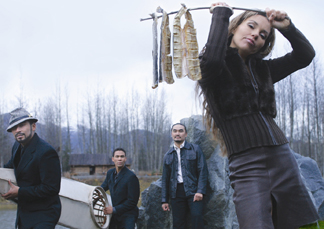“Living in Many Worlds” at NMAI
The National Museum of the American Indian will host a variety of free public programs to celebrate American Indian and Alaska Native Heritage Month in November, including dance, theatrical performances, art demonstrations, films and more. The theme is “Living in Many Worlds,” which explores the dynamic intersection of family, history and cultural identity.
“From Deer to Dance” is a weekend of music, dance and hands-on craft activities that will be held Saturday, Nov. 14, and Sunday, Nov. 15, between 10 a.m. and 3 p.m., in the Potomac Atrium. There will be demonstrations of
deer-hide tanning and painting, bead working and moccasin making, as well as drumming and dance performances by the White Oak Singers (Saturday at noon) and the Kevin Locke Native Dance Ensemble (Sunday at noon). The event is presented in partnership with Target, the Smithsonian Center for Education and Museum Studies, the Smithsonian American Indian Employee Network and the Smithsonian Heritage Months Steering Committee.
In anticipation of the November Heritage events, a 12-foot bronze sculpture, “Buffalo Dancer II” (bronze edition 3; 2008), by Pueblo of Pojoaque artist George Rivera has been installed on museum grounds. On Friday, Nov. 27, Native American Heritage Day, traditional buffalo dancers from Pojoaque Pueblo will perform at the museum.
The museum presents a chamber opera, “El Conejo y el Coyote/The Rabbit and the Coyote” Friday, Nov. 6, at 10:15 a.m. and 12 noon and Saturday and Sunday, Nov. 7 and 8, at 2 p.m. in the Rasmuson Theater. This one-act opera is based on Zapotec stories and is sung in an imaginary language and narrated in English. Reservations are required for Friday’s performance (Call (202) 633-3030). No tickets are required for Saturday or Sunday but seats are limited and available on a first-come, first-served basis. The Sunday performance at 2 p.m. will be presented in Spanish.
On Wednesday, Nov. 11, at 1 p.m. in the Rasmuson Theater, Paul Rosier, professor of history at Villanova University, discusses his book, “Serving Their Country: American Indian Politics and Patriotism in the Twentieth Century” (Harvard Press, 2009). The program includes a discussion moderated by museum historian Mark Hirsch and is followed by a book signing.
The winning entries from the museum’s “Answering the Call: Veterans Day Short Film Contest” featuring short documentaries about Native veterans will be on view Wednesday, Nov. 11, at 11:30 a.m. and 3:30 p.m. in the Rasmuson Theater.
On Friday, Nov. 13, at 3 p.m. in the Rasmuson Theater, the museum will present “IndiVisible: African-Native American Lives in the Americas,” a stimulating and insightful forum moderated by Kevin Gover (Pawnee), director of the museum. This event focuses on bringing visibility to African-Native American lives and initiating a healing dialogue for people of all backgrounds. Speakers include Lonnie Bunch, director of the National Museum of African American History and Culture, along with curators and authors Robert Keith Collins (African/Choctaw descent), Penny Gamble-Williams (Chappaquiddick Wampanoag), Angela Gonzales (Hopi), Judy Kertész and Tiya Miles. Join the exhibition curators Saturday, Nov. 14, at 10:30 a.m. in Room 4018, for a fascinating behind-the-scenes look at the curators’ work on this project and a lively, informative discussion of the challenges and rewards inherent in the richly complex subject the exhibition presents.

The musical group Pamyua reinterprets traditional Inuit music with African influences to create a sound that reflects their own mixed heritage. From left, Pamyua members Stephen Blanchett, Phillip Blanchett, Ossie Kariaiuak and Karina Moeller, 2003. (Photo by Clark James Mishler, courtesy Pamyua)
Join the Kevin Locke Native Dance Ensemble for “The Drum is the Thunder, The Flute is the Wind,” a dramatic performance of traditional and contemporary Native dance accompanied by an eight-member group that includes drumming, vocals and flute, Saturday, Nov. 14, at 2 and 7:30 p.m. in the Rasmuson Theater. Tickets are available at www.residentassociates.org or (202) 633-3030.
On Saturday, Nov. 21, at 2 p.m. Stephanie Duckworth-Elliott (Wampanoag) will read from and sign her book “Poneasequa: Goddess of the Waters,” about a young Wampanoag girl who unexpectedly learns about her culture and herself. The program is recommended for ages 9–12.
“Foodways of the Americas” will take place Friday through Sunday, Nov. 27-29, from 10:30 a.m. – 4:30 p.m. in various museum locations to show the rich heritage of foods of the Americas—from chilies to chocolate. There will be food demonstrations; Mayan, Pueblo, Tlingit and Seminole dancers; and several hands-on activities for families. “Foodways of the Americas” is presented in collaboration with the Smithsonian Latino Center and the museum’s Mitsitam Cafe.
Join us for “Saturday Morning Cartoons” at 10 a.m. in the Mitsitam Cafe, Nov. 7, 14, 21 and 28 featuring family-friendly cartoons from the award-winning “Wapos Bay” and “Raven Tales” series. Hands-on activities that complement the animated shows, including beading and star-quilt patterns, will be presented in the Potomac Atrium from 10 a.m. to 12 p.m. Breakfast specials are offered from 10 to 11 a.m.
There will be daily storybook readings for families at 11 a.m. and 1 p.m. in the Resource Center on the third level. On Wednesdays throughout November at 11 a.m., a 20-minute reading program, “Hok-noth-da,” which means “Did you hear?” in the Shawnee language, is designed for student groups (grades K-4) and families. Children will hear a story and learn about indigenous groups and then venture into the exhibitions to find museum objects related to the story.
All programs are subject to change. For a complete schedule of public programs, visit www.AmericanIndian.si.edu.
Posted: 30 October 2009
-
Categories:
American Indian Museum , Feature Stories , History and Culture





